By Lynne Margolis
When Jimmy LaFave passed away on the night of May 21, 2017, his life was chronicled in respectful obituaries; they reviewed his formative years in Texas and Oklahoma, his move to Austin and a career influenced by Woody Guthrie, Bob Dylan and similar poetic voices who helped establish the folk traditions he followed.
But such documents mainly detail facts: the career highlights, the awards, the beloved family members and partners left behind. They rarely convey what makes a person truly special — what makes their friends and significant others love them when they’re alive and miss them when they’re gone. They rarely relay the priceless stories friends and colleagues tell one another, simultaneously laughing and crying, or reveal details such as the fact that, the day LaFave made his final farewell from the Paramount Theater stage at the Songwriter Rendezvous held in his honor on May 18, he’d expressed hope that he would be able to strum the first chord of the final encore, “Goodnight, Irene.” Instead, he ended up singing the entire song, absorbing the love radiating from every person in that beautiful theater and, like he always did, shifting it back on us.
“It was almost transcendent, just the energy that he exuded. And his voice, right at the end, got really strong,” observed Kerrville Folk Festival producer Dalis Allen. “His joy and determination far outweighed any struggle that he was undergoing.”
As usual, she’d booked him for his first-weekend performance at the annual gathering, one of the country’s oldest folk festivals.
“He played every year; we couldn’t do it without him,” Allen explained. When the usual confirmation didn’t come, she called. He told her he really, really wanted to play there one more time.
Instead, his Friday, May 26, headlining slot will be a memorial celebration featuring Ray Bonneville, Michael Fracasso, Jaimee Harris and his band, the Night Tribe (bassist Glenn Schuetz, drummer Bobby Kallus, guitarist John Inmon and keyboardist/accordionist Radoslav Lorković), plus whoever shows up to join in.
They and so many of LaFave’s friends, including Christine Albert, Eliza Gilkyson and some of the nearly 40 musicians who appeared on the Paramount stage, have held similar informal tributes all week; local radio airwaves also filled with LaFave’s voice — a high tenor that magically turned vibrating air into the sound of a broken heart. Or sweet forgiveness. Or a thousand other miraculously nuanced expressions of emotion, channeled directly from his soul.
“Any song that he did, whether it was somebody else’s or his own, it was like an internal thing that he just allowed us to share,” Allen notes. “It just kind of came out of him. It went in, got Jimmified, and came out. … He made everything he did his own, with a great deal of emotion and honesty.”
Out of Time
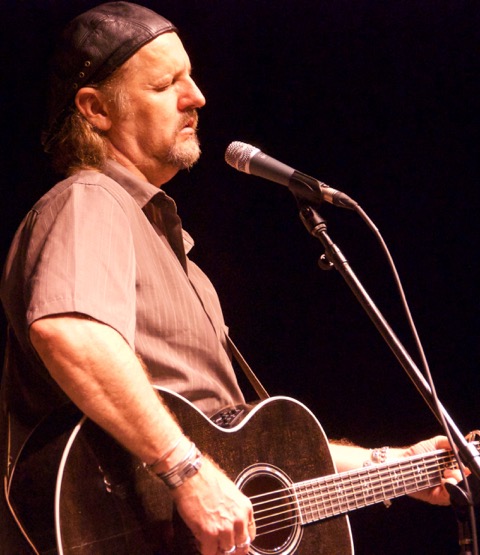
Jimmy LaFave at Woodyfest 2012 in Okemah, Oklahoma. (Photo by Lynne Margolis)
When he quietly started revealing his terminal cancer diagnosis to friends, several of us found out while attending February’s Folk Alliance International conference in Kansas City. Somebody asked me two days before I left for that conference if it was true he had terminal cancer. I’d seen him just a few months before at the Americana Music Association conference in Nashville and he seemed fine. I didn’t want to believe it, but said I’d check it out. I didn’t have to; when I spotted him from an escalator, I knew. He revealed he’d discovered a lump on his chest while driving to that same conference the year before. But he also told me he had “maybe a year” left. I soon learned that was wildly optimistic; maybe he just didn’t want me to feel sorry for him or cause me to lose it completely right there in the Westin Crown Center lobby. “Maybe a year” sounds like “there’s time” — and even hope. “A few months” is no time at all.
But two nights later, that’s what I learned he had. With John Fullbright in tow, I somehow muscled my way into a far-beyond-capacity showcase he was playing in a room much too small for the crowd who desperately wanted to hear him. He might have been singing Dylan’s “Not Dark Yet” when I got there — or maybe it was his own “I Wish for You.” I can’t recall, and don’t have any notes. I couldn’t write just then; I was too busy facing the wall, trying to muffle my uncontrollable sobs. Everyone else who knew was sobbing, too.
I hugged him for so long afterward, someone joked, “Get a room.” Now, Jimmy’s friends were well aware of his chronic flirtatiousness; it was a running joke among many of them. In the past couple of years, nearly every time I’d seen him, he’d mentioned how much he loved the Facebook photos an old friend had posted of me in my college newspaper days. He thought they were very sexy, and made a point of telling me so often, I started to wonder if the admiration was … more than casual.
Jimmy indicated he liked the room idea. “You wish,” I responded. Those around us laughed. He grinned; a little glint in his blue eyes seemed to suggest he still held a tinge of hope. That’s the nature of flirting; the suggestion of possibility, even if it’s not real. And in Jimmy’s case, that was the nature of dying, too; trying to find moments of lightness despite the weight of all that pain and anguish.
“He was a shameless flirt, and people may think him a cad for that, but he was not really,” his friend and fellow Austin musician BettySoo confirms. “It was a funny entertainment and kind of a joke more than anything. If anyone told him to cut it out, he would. … He once told me he would never ask me to sing ‘Hideaway Girl’ with him onstage because he didn’t want people to start rumors about me cheating on my husband at the time.”
Lorković, one of LaFave’s closest friends and most frequent collaborators, says of that “relentless” flirting, “No one was excluded. All appropriate demographics were included. He always had that tenor-voice laugh and snicker as truly hilarious off-color [comments] rolled off the tongue. It was never misinterpreted, and always welcome.”
Well, maybe not always, BettySoo notes. But she adds, “He told me at the end — he was kind of laughing — when his appetite had gone, and his sex drive had gone, all he was interested in was spreading love and being with Jackson and letting Jackson know how much he loved him.”
As if that hadn’t already been evident, he made sure everyone in the Paramount — or watching the live concert stream — knew it.
“This is my son, Jackson,” LaFave said in a frail voice, as the handsome, dark-haired 15-year-old stood behind his father’s wheelchair. “You guys, take care of him, take care of him for me, please. I love him so very, very much. He’s a great kid. Take him into the community and nurture him. Thank you so much.”
Through the tears and cheers, the promise was sealed. As his father took one final bow, Jackson’s family grew exponentially.
Walking Jimmy’s Road
I can’t remember when or where I first met Jimmy LaFave. I had begun learning and writing about Woody Guthrie while still living in Pittsburgh before moving to Austin in late 2003; we might have crossed paths in Pittsburgh, or Cleveland, where I covered nearly every event that happened at the Rock and Roll Hall of Fame & Museum from its 1995 opening till I moved (though I foolishly missed its first American Music Masters series presentation, a weeklong Woody tribute during which LaFave first shared a stage with Bruce Springsteen). Maybe it was at the Museum of the City of New York, at the early-2000 opening of the Smithsonian Institution’s first traveling exhibit: “This Land is Your Land: The Life and Legacy of Woody Guthrie.” Or maybe it was in Nashville, where the 2003 Folk Alliance International conference was held in February, along with Woody’s 90th-birthday celebration. That’s where the LaFave-organized “Ribbon of Highway, Endless Skyway” Guthrie tribute debuted. Somewhere along the way, it morphed into “Walking Woody’s Road.”
On booking manager Val Denn’s website, a description of the multi-artist show begins with a LaFave quote about his inspiration: “He was a man who picked up a guitar and used his voice, personality and common-man language to speak to the human condition.”
The same could be said about Jimmy. Countless traditional and social media tributes have noted his ability to touch souls with his words, music and beautiful voice — and traits such as his boundless generosity and willingness to help fellow artists. That appreciation also manifested as a GoFundMe.com campaign that raised over $55,000 in one month — not to help with medical bills or Jackson’s college fund, but to go toward favorite LaFave charities. His obituary also suggested that, instead of flowers, well-wishers could donate to a pet charity – “or simply perform an act of unsolicited kindness.”
That’s Guthrie’s populist spirit, channeled directly.
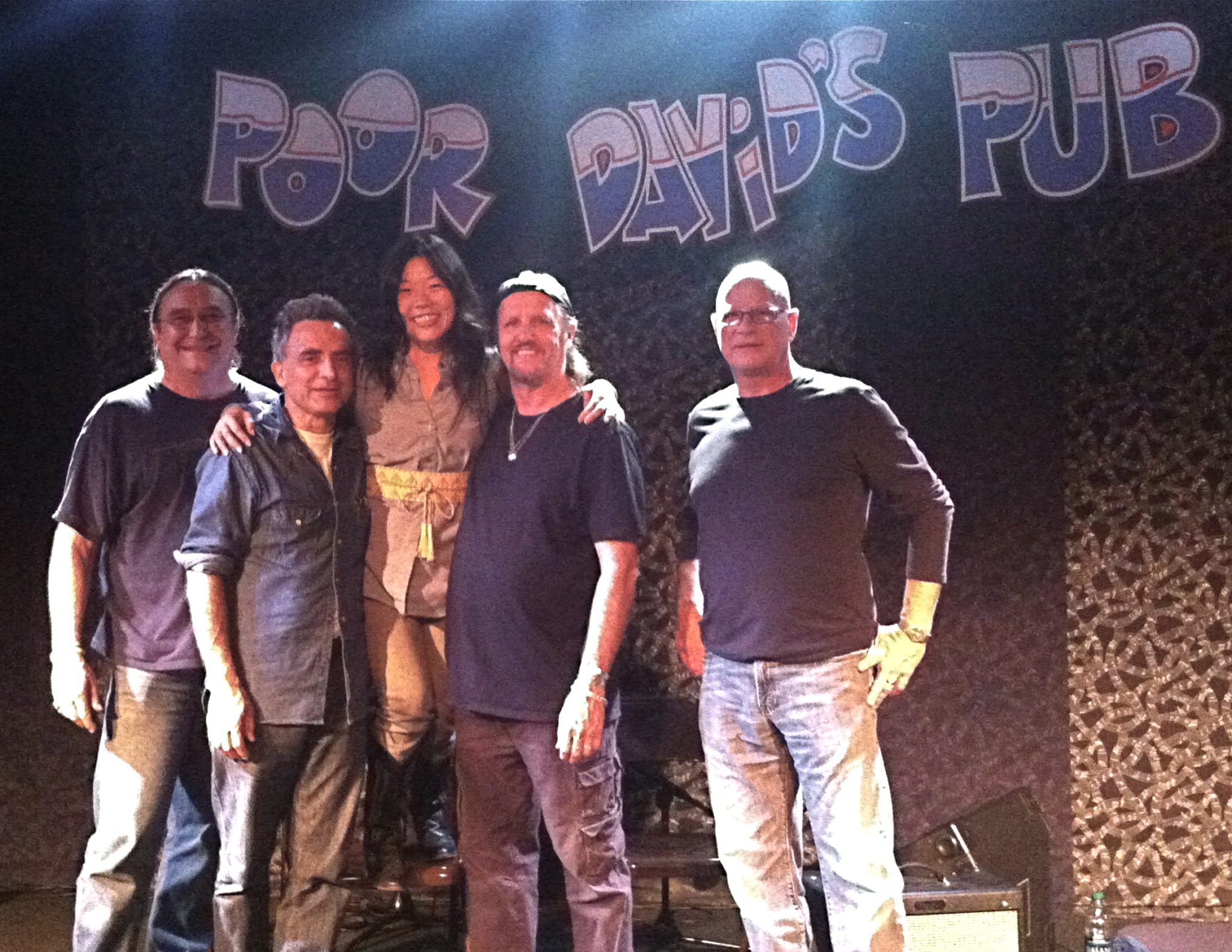
Jimmy’s Gang: (from left) Bobby Kallus, Michael Fracasso, BettySoo, Jimmy LaFave, and Glenn Schuetz at Poor David’s Pub in Dallas, 2012. (Photo by Tiffany Walker)
So Many Connections
“The first Folk Alliance [conference] I went to was in 2006 in Austin,” recalls BettySoo. “I had no idea what it was or what I was doing. I popped into a couple things and basically skittered away in confusion. Then Jimmy told me to go to Memphis in ’07.”
That was the year then-FAI director Louis Jay Meyers relocated the organization’s headquarters to a city more known for blues than folk, anchoring the conference there for several years in a move that helped heighten its profile. By then, LaFave was already a fixture of Folk Alliance conferences, just as he was at the Kerrville Folk Festival each spring and Okemah, Oklahoma’s WoodyFest in July (he served on the festival’s advisory board). When he partnered with Kelcy Warren to form Music Road Records, his presence grew even bigger; for the past several years, every conference-goer staying in the host hotel used room keys bearing Music Road’s logo.
Of course, BettySoo took his advice.
Shortly after her arrival, she says, “He found me immediately and looped my arm in his. It was one of those cocktail/snack meet-greet social hours. He started at one end of the hall, escorting me slowly. One by one, presenters, DJs, writers, agents — all kinds of people — came up to talk with Jimmy. He immediately would introduce me, saying, ‘This is BettySoo. She is one of the best new songwriters in Austin, and she is a really great singer. You should really think about working with her. She’s gonna be the hot new star.’ [He repeated it with] little variation from stop to stop. Almost all these people would probably never have stopped and chatted with me and asked about what I was doing if not for him.
“We promenaded from one end of the hall to the other and back again. He diverted attention from himself every single time.”
In 2012, When Nora Guthrie, Woody’s daughter, announced the Woody Guthrie Archives would move from New York to a new Woody Guthrie Center in Tulsa, Oklahoma, LaFave was there for the celebration, part of a year of “Woody at 100” events that culminated with a performance at the Kennedy Center in Washington, D.C. A week later, while discussing Woody on a South By Southwest panel with Nora and her brother Arlo, among others, LaFave noted the state had finally begun appreciating “the most famous Oklahoman in the world.”
“The great joy for me last week was seeing Mary Jo [Guthrie Edgmon, Woody’s sister] live long enough to see the vindication of her brother in that state. His painting is now in the Capitol; ‘Oklahoma Hills’ is the state song. … People that are moving and shaking in Oklahoma are finally coming to terms with it.” After suffering years of vilification by those who’d branded her brother an atheist and actual Communist (he was neither), LaFave said, “It was like this scarlet letter was finally taken off.”
LaFave wasn’t thinking about what that development meant for his career; he was thinking of how it affected Woody’s family and the state where his career began.
Though he wasn’t born in Oklahoma, LaFave moved to Stillwater as a teen and began making his mark soon after, helping to establish red-dirt folk as a musical style.
When he released his last album, 2015’s The Night Tribe, I was asked to write his press bio. He said then that he felt lucky to have had opportunities to make connections with so many of his musical heroes, from Dylan and Neil Young to Joni Mitchell and Jackson Browne, but particularly with Woody. Then he confessed, “I actually have About 20 Woody songs that Nora gave me to put music to. That’s one of my upcoming projects. I’ve had them around seven or eight years. I can’t wrap my head around it to get it done because it’s so intimidating. Everybody else just takes ‘em and puts music to ‘em, but to me, it’s almost sacred.”
Before the Paramount, I last saw him perform in March, a couple of weeks after the Folk Alliance conference. I begged him then to please get busy; to please record whatever he could. He promised he was working on it. I don’t know how far he got; he also had songs of his own he wanted to leave behind. I’m hoping we’ll get to hear them. I’m also hoping his friends will continue “Walking Woody’s Road” — in his name as well as his biggest inspiration’s. He was so involved in Guthrie’s legacy, he’d certainly want that.
BettySoo and Jaimee Harris are ready. Harris, who became a close friend under LaFave’s mentorship, was the first artist to perform at the Paramount tribute. Two days later, she and his bandmates filled his slot at the Cherokee Creek Music Festival, an annual event held at Warren’s ranch outside Llano, Texas.
“One of the reasons we’re having Jaimee is because she’s one of the young artists that he has supported and acknowledged, and [he] helped her to blossom,” Kerrville’s Allen said, noting that nearly everyone onstage at the Paramount related similar experiences.
“I was first made aware of Jimmy LaFave when my dad suggested I listen to his cover of ‘Walk Away Renee,’ Harris recalls. “By the time Blue Nightfall was released [2005], I was hooked.” That was right around the time she began writing songs and playing gigs; she studied melody and phrasing by listening to his albums while driving, singing harmonies as she rolled down the road.
“When I first moved to town, I spent a couple of days busking downtown to afford a ticket to see Jimmy and Patty Griffin at Antone’s,” Harris relates. “I knew they’d only be playing a few songs each, but I didn’t care. I wanted to go. It was a benefit for a local musician who had recently had a stroke: Will Sexton. I didn’t know Will yet, or many of the other local musicians who would later become my friends.
“At some point, I’d confessed all of this to my friend Noëlle Hampton. When Jimmy asked Noelle to bring in some background singers for The Night Tribe, she graciously offered me the gig. Jimmy had never met me, heard of me, or even heard me sing. But he trusted Noelle, so he trusted me. In between tracking the first and second songs, we took a short break. As I stood in the hallway, looking at all of the records on the wall — records that were made at Cedar Creek — Jimmy came up behind me. ‘Do you know any of those records?’ he asked.”
She remembers gesturing at the wall, stunned at the enormity of those symbols: The Dixie Chicks’ multi-platinum Home, Uncle Tupelo’s Anodyne, Shawn Colvin’s A Few Small Repairs. “This is the reason I live here,” she told him. After the session, he asked her to let him know about her future gigs; he wanted to hear her originals.
“I was shocked the first time I saw Jimmy at one of my shows, but there he was,” she remembers. “That unmistakable silhouette — that hat [his ever-present backward-billed flat cap] — the light reflecting off each piece of jewelry.” He became one of her biggest champions that night, inviting her onstage, having her open his shows and recommending her to other artists, three of whom hired her to record backing vocals.
“I know I’m not the only person with this story,” she adds. “So many other artists could tell you a similar story of how Jimmy’s trust led to bigger and better things for them. When I met BettySoo, she instantly took me under her wing … . I see so much of that same spirit Jimmy has in her, and I’m so grateful for both of them.
“He was my superhero,” she says. “He still is my superhero.”

A Friend in Need: Jimmy LaFave at the 2010 Will Sexton benefit at Antone’s. (Photo by Nichole Wagner/Uncommon Music)
Radoslav’s Road Tales
Radoslav Lorković could likely fill a book with recollections of his travels with Jimmy. Though they met in 1995, he says, “The defining moment was spring 2003. I was smarting from a fresh divorce in Montana and drifted eastward. I found myself opening for Jimmy at the amazing Mansion series in Middletown, New York. The promoter, Steve Coccia, saw potential here as a musical matchmaker. I opened the set and shortly found myself in the band. It was a bit surreal. It was as if we had been playing together for 20 years. We actually had. Just in different bands. He immediately committed to having me play on his upcoming record, which was to become Blue Nightfall. It took a few months, but shortly before the session, he had me join him at the rather impressive Hardly Strictly Bluegrass Festival in San Francisco. I spent four fabulous days hanging with the most amazing musicians and friends. He blew in for our set and was gone in a flash. The die was cast.
“Two weeks later, he had me in the keyboard booth at the fabulous Cedar Creek studios. He set four days aside for keys tracks. Seven hours later, I had completed 30 or so piano and B3 tracks. Done.
“It was time to tour. The first run was built around the [2005] Folk Alliance conference in Montreal. … I somehow jumped from the van I was riding in to Jimmy’s van. The guys greeted me with grins. …
“Jimmy earlier spoke of a previous band member who always made erudite intellectual references and continually retorted [to others’ remarks] with the comment, ‘And your point would be?’
“As we drove, Jimmy made some vague comment [like], “Wow, the clouds are really wispy.” I immediately retorted, ‘And your point would be?’ The van erupted in laughter. High fives came my way. Jimmy conceded, ‘Twenty points for Rad.’ They had a system for scoring jokes.
“Jimmy set up almost every show as a treasure hunt for me, probably due to my lone-wolf nature. I would drift in and out of tours on my own and often travel separately. I often paid the price in extra teasing. ‘Never leave the pack Rad,’ I would hear over and over.
“He let me in on secret special stuff, too. [In 2005], there was a memorial service for the [fiancée] of Terry Magovern, Springsteen’s right hand man. Jimmy informed me at 1 a.m. He gave me the name of the church and the New Jersey town where the service was. … I did my research and drove nearly 100 miles to a motel where I would be in position. After a very short night, I pull up to the church. There is Bruce and Jimmy and a crew. Jimmy and Bruce are chatting. I’m appropriately quiet and a bit tongue-tied. Mostly grinning. … Then Magovern pops in and says, ‘You guys are up! I don’t want to see a dry eye in the house!’ We oblige, and apparently, deliver. Then Bruce got up and tore the church down, as expected.
“Then there was the memorial celebration at another church. I quickly race over there. … The place is packed. The band onstage was wearing outrageous ‘50s-vintage clothing. … I naturally get up there. Just then, Jimmy waves goodbye. … I stay.”
Eventually, he found himself jamming with several of Springsteen’s E Street Band mates and face-to-face with the Boss himself. LaFave loved retelling that story, often embellishing it to place Lorković onstage with the entire E Street Band.
“He would fixate on stories about me,” Lorković claims. “He told them over and over, almost parading me, in a way.”
LaFave often talked about his bandmates, according to BettySoo. “He would always praise his band when they weren’t around. He wasn’t one of those guys who would bash them behind their backs.”
And he didn’t just praise musicianship; he also lauded their character, intelligence and occasionally even their relatives, and noted “how smart and cool each person is and how he respects them as people and loves them.”
“On the other hand,’ she adds, “he loved to rib on a repeated topic and just run it over a few more times to tell you, ‘I got my eye on ya. I know what’s going on … I know something not everyone knows about you.”
Nudge-nudge, wink-wink.
Among the “Jimmyisms” echoing in Lorković’s head:
“Rad, I like what you’re ‘trying’ to do.”
“I wasted no time listening to your CD.”
“Rad, you ‘always’ cease to amaze me.”
Whether they induced knee slaps or groans, they leavened their moments. Lorković and his bandmates undoubtedly will trade “Jimmyisms” this weekend and for some time to come. Harris, BettySoo and so many others will, too.
But BettySoo surely speaks for all of them when she laments, “What I wouldn’t give to hug his neck one more time. To hear him sing live one more time. To hear his laugh after an inappropriate joke one more time.
“I love him. I really miss him,” she says. “I’m always going to miss him.”
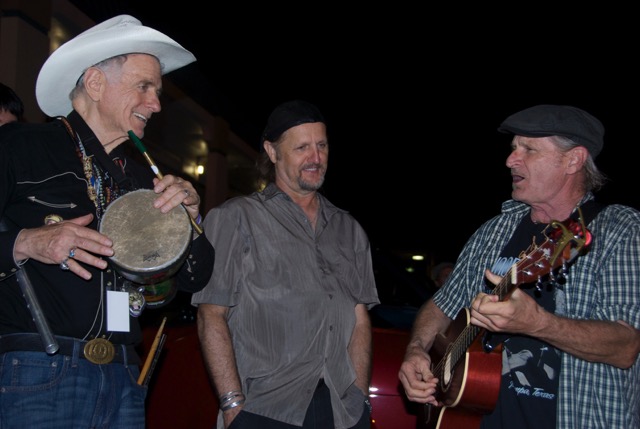
Night Tribe: A 4 a.m. Woodyfest jam session with David Amram, Jimmy LaFave, and Butch Hancock. Longtime friends LaFave and Hancock shared a July 12 birthday; Guthrie’s was July 14. (Photo by Lynne Margolis)
From Woody to Bruce and Back
One of LaFave’s last hurrahs happened the final weekend in April at the Woody Guthrie Center, where he performed after being interviewed by Bob Santelli, executive director of the Grammy Museum. Working with Nora Guthrie, Santelli, who started his museum career as the rock hall’s education director, had coordinated that American Music Masters Woody Guthrie event at which LaFave and Springsteen performed, as well as the year of “Woody at 100” activities that put LaFave onstage at the Kennedy Center. Santelli met LaFave through Nora, whom he’d gotten to know when another Guthrie scholar, author and critic Dave Marsh, asked him to help sort through what would become Woody’s archives. That was in 1988. By then, Marsh, who is married to Springsteen’s co-manager, Barbara Carr, had written two Springsteen biographies and turned his attention to Guthrie.
Marsh first met LaFave at that rock hall tribute; over several Folk Alliance and Southby gatherings, they became friends, bonding over Woody, Bruce, Dylan and other shared musical touchstones, as well as political philosophies. By 1996, Marsh had already lost the stepdaughter he’d raised as his own; she died at 21 of liposarcoma. Much of the research into sarcomas has since been funded by the Kristen Ann Carr Fund established in her name.
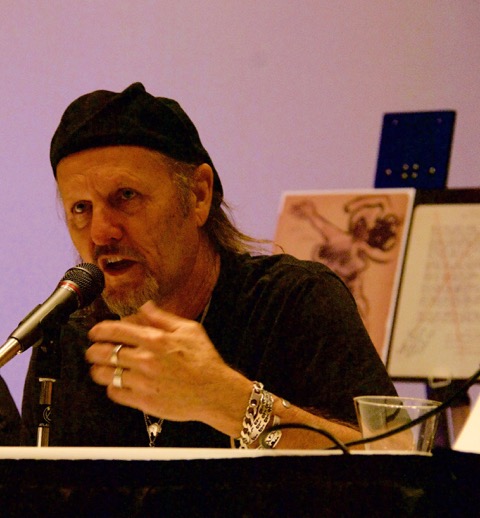
Jimmy LaFave addressing Woody Guthrie’s continued relevance on a panel at the 2016 Americanafest in Nashville. (Photo by Lynne Margolis)
That sad irony at least gave LaFave a critical information source in Marsh as he tried to battle his rare, aggressive spindle-cell sarcoma — and made Marsh the most eloquent of those writing and speaking about their love for this gentle man. Marsh repeated has noted LaFave’s courage and grace in choosing to keep performing rather than continuing treatment. As hard as it was to accept, LaFave told Santelli, at least, like Woody, he knew he was going to die, so he could get to say goodbye to his friends and his son, unlike dying in a car crash or some other sudden manner.
But even saying goodbye doesn’t make exiting easier, or soothe the grief of those left behind. Two days after his death, Nora was still too stricken to offer comments for this tribute. During that interview, though, she sat up close to her friend, and when Santelli asked if she recalled her first meeting with LaFave, she answered, “Yes, I do. It was at a concert as part of the Folk Alliance, maybe 20 years ago. And someone, a friend of mine, said, ‘You should hear him.’
Addressing LaFave, she said, “I went to your set, and it’s engraved like a movie in my memory. … I can see you, the tone of voice, the way you sang, the way you held your guitar. And for me, that was it.
“You encompass this space in my life and my work with Woody. And it’s a singular space,” she told him. “There’s only room for one person in this place that you hold, and it’s you. There’s not 10 people; there’s not other people. It’s just you. That’s the impression that you made on me the first time I heard you sing.”
She was hardly alone. And she also picked up on his understanding of what her multifaceted father’s life was about.
Santelli told LaFave that, unlike bigger artists who might do an evening, or even an album, of Guthrie material, “You were living it. You embodied more than just the songs. You embodied the message.”
LaFave explained the attraction went far beyond song lyrics; he mentioned Guthrie’s radio show, his Merchant Marine stint, his fascination with Einstein, the time he fought the Ku Klux Klan in the Florida swamps.
“There’s so much more to him than this dustbowl motif that he was put into,” LaFave added.
And there’s so much more to LaFave than his role as a torchbearer of Guthrie’s legacy. But if it’s the link that connects him to posterity in the world beyond Kerrville, the Folk Alliance and his cherished friends, it’s certainly a worthy one.
Among the myriad social media tributes still pouring in, Noëlle Hampton posted, “Last night [my husband] Andre and I were huddled around a table of friends and their kids after dinner in L.A. and we were playing songs. The kids asked if we knew ‘This Land is Your Land.’ We told them our dear friend Jimmy LaFave ended many of his shows with that song and that he had just passed away. We proceeded to all sing it all together, and I swear we all felt him there.
“Safe travels Jimmy,” she added, “The younger generation has your back.”
For his Night Tribe bio, LaFave and I discussed the manifestations of Woody’s legacy. He wasn’t concerned about whether “This Land is Your Land” should be used in a Super Bowl commercial, as it was that year, or whether everyone always sang each verse. He simply said, “I would love to have a song that, after I’m dead 40 years, people are still listening to.”
There are so many that might qualify.
This one is the final song on that album, written in honor of lost friends and anyone traveling on this journey through life. It’s a perfect benediction for a man who worked so hard to fill the world with love.
Farewell, friend. We’ll try to take good care of our hearts. And yours.
“The Roads Of The Earth”
Peace be with you my friend
Wherever you’re traveling
Until we meet again
Take good care of your heart
I’m sending good thoughts your way
Life is a passion play
Especially on rainy days
We can all hurt
I need you to rise above
And fill your world with love
As you move around the great big universe
In the click of a photograph
It all passes way too fast
And when your part is cast
There’s no time to rehearse
May all your joy be true
That’s what I wish for you
As you’re traveling the roads of the earth
I know you will rise above
And fill the world with love
As you move around the great big universe
In the click of a photograph
It all passes way too fast
And when your part is cast
You could do worse
May all your joy be true
That’s what I wish for you
As you’re travelling the roads of the earth
As you travel the roads of the earth
– Jimmy LaFave




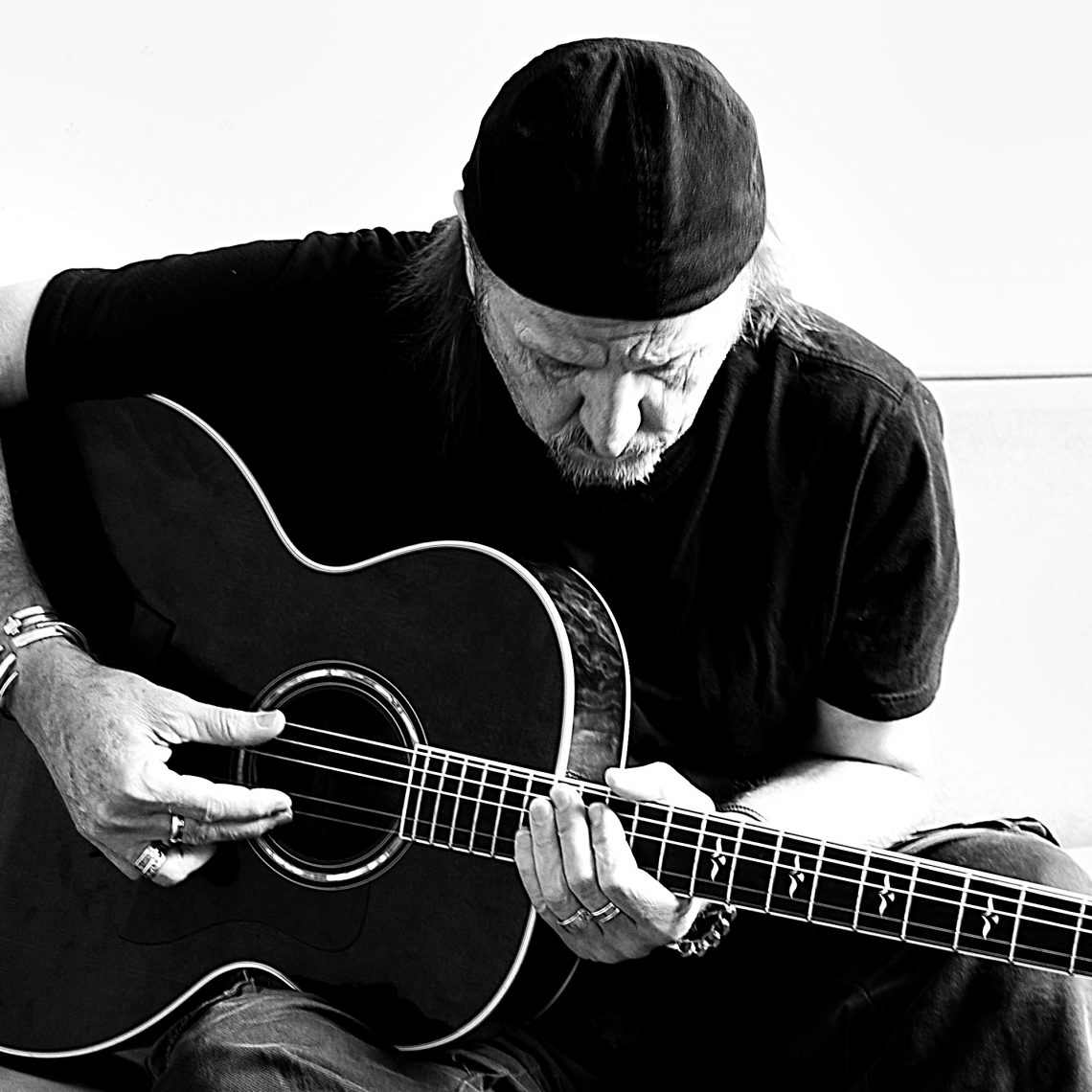

This is such a beautiful read Lynn. I thought I knew Jimmy well, but now the feeling is so much deeper. I appreciate your time in the sharing of these thoughts.
Lafave was a beautiful man with a remarkable talent as a singer and a songwriter. I have read many articles on Jimmy over the last 25 years, and this is by far the most penetrating and in-depth. I am sure Jimmy would agree.
” I’d seen him just a few months before at the Americana Music Association conference in Nashville and he seemed fine”
I saw him at Americanafest, also. I had never seen him in person, but I got to talk to him for a few minutes after his set. I had no idea of his medical issues at the time.
I enjoyed reading such an in-depth article.
Thank You for a great insight into this great guy